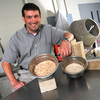Blocks made from scratch (and scraps)
Posted by magazine

John Myers with wood fibers and fly ash used to create an environmentally friendly construction material. Photo by B.A. Rupert
John Myers can’t say no to leftovers, particularly when fly ash or wood fibers are on the plate.
Myers, associate professor of civil, architectural and environmental engineering, has created an environmentally friendly construction material that consists primarily of class C fly ash, a byproduct of coal-burning power plants, and wood fibers.
“In Missouri, a sizable portion of our power generation still comes from coal,” Myers says. “What we’ve done is taken fly ash from the power industry and wood fibers from unused timber products, such as upper tree limbs, and we’ve developed a new, green construction material.”
The composite material, made from two materials that otherwise would be put in the nation’s landfills, has advantages over traditional clay bricks and concrete masonry blocks. The material is lighter, more durable and less brittle than clay bricks or concrete masonry blocks. The composite blocks also are fire and impact-resistant, easy to mold, and less expensive to manufacture because they are made from largely recycled waste materials. A chemical additive also makes the blocks mold resistant.
Myers began refining the wood fiber and fly ash composite material concept in 2003 in partnership with Robert Sinclair, president and CEO of Encore Building Solutions Inc. in St. Louis.